Scientists Have Answered the Most Mysterious Question About Curling
Why does the stone curl?

Every four years, the Winter Olympics enthralls and intrigues onlookers with the popular if inexplicable Scottish sport curling.
The first confusing bit is why a sport in which players use brooms to direct a series of stones across the ice is even called curling at all. Why not ice-broom, or ice-stone, or the especially impressive-sounding broom-stone? It actually gets its name because the stones being slid across the ice always curl a little to the left or to the right.
But that just raises the next long-unanswered question, as scientists have been trying to explain why the stones curl for almost a hundred years without much success … until now.
About a year ago, University of Alberta researcher Edward Lozowski woke up early one morning and came up with a formula that might hold the answer to this age-old question.
“I don’t think I was dreaming about curling, but I just had this idea,” Lozowski, who has authored multiple studies on the physics of curling, tells Inverse. “I had to start writing down some equations and did some back-of-the-envelope calculations. Lo and behold, I came up with an idea that led to the right total pivoting time [of curling stones].”
For years, scientists had settled for the simple explanation that friction between the ice and the stone is what causes it to curve off to the side. But Lozowski joined forces with another curling physics expert, Dr. Mark Shegelski from the University of Northern British Columbia, to try to prove there was more happening on the ice.
In a paper published in Cold Regions Science and Technology, the duo proposed that the curling is caused by small pivots, which occur when the stone momentarily sticks to small ice pebbles.
The ice on a curling sheet is not perfectly flat. Before the event, the “ice maker” goes on the ice and sprinkles droplets of water onto the playing surface, creating a pebbled surface. This is what causes that roaring noise heard when the rock is traveling.
When the stone comes into contact with these pebbles, it sticks for a moment, slightly changing the stone’s direction, and then it continues to slide, a cycle known as stick-pivot-slide. This is repeated thousands of times as the rock glides on the ice, causing a noticeable curl, the distance of which Lozowski and Shegelski have attempted to quantify.
Unlike many of the other papers published on the topic, this study was able to calculate the curl distance of a stone using an equation with up to 10 variables, most of which have to do with the ice.
The formula takes into account the radii of the rock and the running band — or the coarse ring at the bottom of the stone — as well as the size and density of the pebbles on the ice, the hardness and elasticity of the ice, the speed of the stone, and the time it takes to go down the sheet.
“This doesn’t mean our equation is exactly right; maybe we just got lucky,” Lozowski says with a chuckle. “But to have so many variables, and when you put in the estimated numbers for them, to come out with a distance that is even close to what you observe, is remarkable, and it suggests to me that it isn’t just an accident.”
So when you’re cheering on your favorite curlers, remember that this sport is as much a marvel of physics as it is a game of strategy, finesse, and strength.